绿色、社会和组团
绿色、社会和组团
Green, Social and Complex
凭着巨大且全面的责任心——工作地点在蒙特利尔的L'OEUF事务所的建筑师证明,实施环保型建筑体系不是金钱问题,而是决心问题。
乍一看本尼农庄毫无稀奇。驱车从旁经过,位于蒙特利尔内城边缘的恩宠圣母区附近的住宅发展几乎引不起任何注意。像这样经历了60年风雨的砌砖建筑在蒙特利尔到处都是。但是本尼农庄的意义远不止视觉所见。“本尼农庄是一个梦想。”L'OEUF的建筑师丹尼尔·玻尔说——是他和他的共同创始伙伴马克·波杜比乌克在过去15年中孜孜以求的梦想。最近,他们的第三个合作伙伴贝纳德·奥利维尔,和生物气候工程师马丁·罗伊也全心致力于建设共同的愿景——这个愿景不仅为该团队赢得了北美地区豪瑞奖金奖,也荣获全球豪瑞奖铜奖。
灵感来自斯泰因和勒·柯布西耶
该团队的故事从第二次世界大战之后开始。1947年,在前本尼农庄的土地上为退伍军人及其家人建起一个住宅群。这个住宅项目由政府资助,占地7.28hm2(约合18英亩),共有近400座公寓,是加拿大同类住宅项目中最大的一个。建筑师哈罗德·多兰从与其同时代的进步思想家那里获得灵感,将本尼农庄设计成一个勒·柯布西耶风格的花园城。3层的建筑分布在开阔的绿地上,户外社交空间各式各样,本尼农庄成了一个住宅公园。老兵们对这个综合住宅区的生活质量,尤其是社区氛围评价很高。他们大多数都在这里住了几十年,在这里养儿育女。丹尼尔·玻尔说,“有一段时间本尼农庄的孩子很多,他们举办了自己的曲棍球联赛!”
白板
到了1980年代后期,农庄的发展已经落伍过时。建筑外壳和基础设施(机械、电气和管道系统)不再符合现代标准。由于小区内原有居民或去世,或搬入养老院,空置的公寓越来越多。1990年代初,本尼农庄的业主CMHC(加拿大抵押贷款和住房公司)考虑将小区发展私有化。CMHC委托蒙特利尔建筑师研究这个问题;得到的回馈建议对本尼农庄来说是毁灭性的——这个过时的小区应该被彻底拆除和替换。推土机很快就开到现场,实际上,第一批楼已经被撞到了。如果不是受到突发的、声势浩大的强烈抗议,本尼农庄很可能就这样被夷为平地了。“我们感兴趣的不是重建本身,而是重建所代表的有趣环境下的社会生活。”丹尼尔说,他和他的L'OEUF同事马克都强烈反对拆除计划,“在我小时候,空闲的日子里我可以在早上离开家,晚上才回家。我的父母从来不知道 我一整天都在哪儿闲逛。如今的孩子再也不能拥有像我当初那样的邻里关系了,他们不能在城市里自由自在地到处活动。但是在本尼农庄,他们可以!这里的小孩子还可以在房屋之间的绿地上长大。”
拆迁抗议者获得了极大的同情。媒体报道了这个故事。本尼农庄引发了关于如何处理旧建筑结构的讨论。推土机离开了现场,政府把这里的土地和建筑物转让给另一个国有公司CLC(加拿大土地公司),该公司寻求替代拆除的方法,要求建筑师们为本尼农庄的未来提出建设性建议,其中包括L'OEUF。
建筑师、理想主义者——活动家
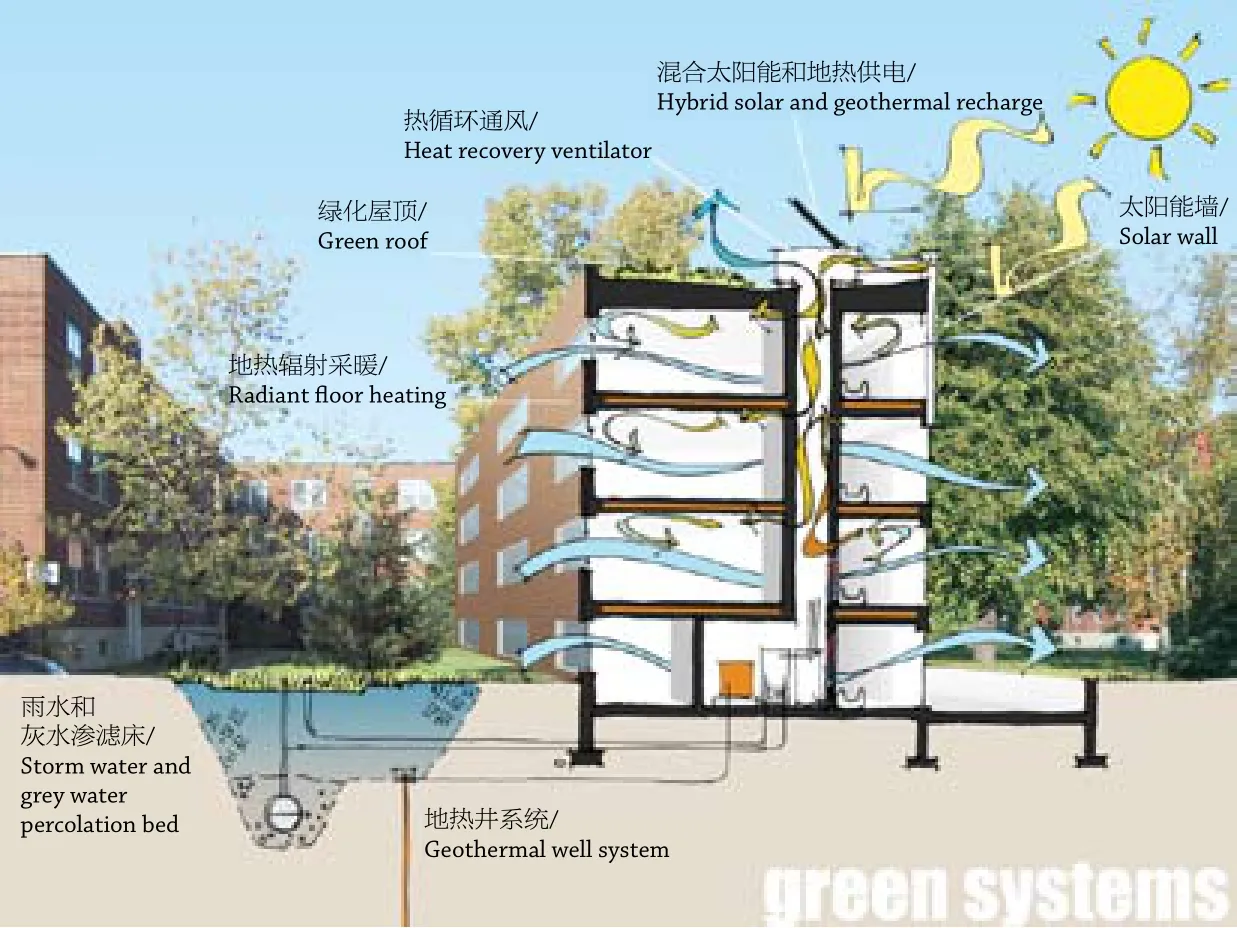
2 绿化系统/Green systems

3 社区基础设施/Community infrastructure
L'OEUF不是经典意义上的建筑事务所。该事务所有10名雇员,他们日常工作的很大一部分是准备社会和环境评估。这一点体现在L'OEUF为本尼农庄设计的项目中:L'OEUF建议保留大部分建筑物,对其进行大规模改造,并安装环保型建筑系统。“我们希望提供低成本、高品质的住宅空间和绿色基础设施,”丹尼尔解释说。与此同时,制定并提出新的项目社会理念:全部管理应当由非营利组织掌握。“我们是理想主义者,”玻尔说:“通过本尼农庄,我们也成了政治活动家。我们知道,假如本尼农庄被私有化,那这些住宅单元最终只能为有钱人提供经济实惠。但是,我们希望钱少的人也能拥有良好的生活环境。在我们的社会中,严重缺乏对经济上不富裕的群体的尊重。我们要反抗这种现象!”
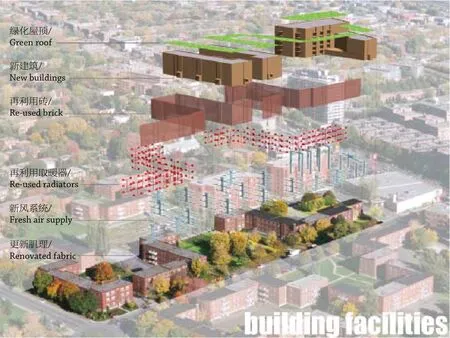
4 建筑组团/Building facilities
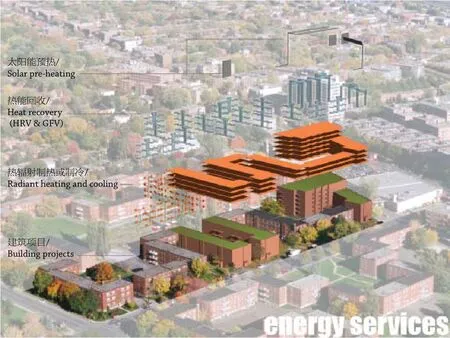
5 能源设施/Energy services
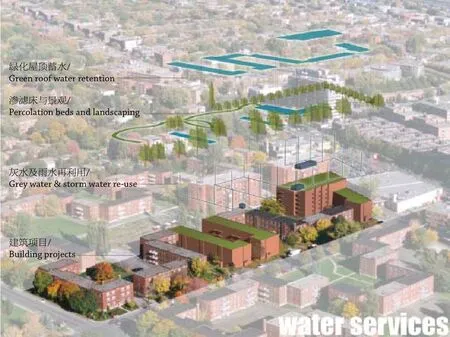
7 水处理设施/Water services
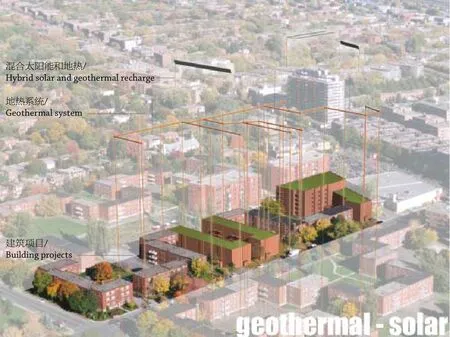
6 混合地热和太阳能/Geothermal-solar
3个居住群体的3座建筑
L'OEUF的示范项目的核心是3座建筑的综合效果,共包括187套住宅单元。每座建筑都是针对不同的居住群体设计。第一座建筑包括30个翻新单元和一个16套公寓的新厢房,供经济困难的家庭居住。第二座是一座与整个住宅区完美融合的新建筑:一个拥有91个低成本单元的养老院。2006年夏天,这座养老院开放后才几个月,就已经几乎全部住满了。第三座建筑是本尼农庄最早的建筑之一,它将被装修一新,为首次购房者提供实惠的公寓。它包括30个翻新单元,和一个20多个房屋单元的新厢房。每座建筑分别由专为该项目设立的不同的非营利组织管理。3座建筑的共用基础设施由另一个非营利组织——绿色能源本尼农庄 (GEBF)管理。“是的,我们在最近几年帮忙建立了许多公司,” 丹尼尔·玻尔笑着说,“在过去的两年里,我处理的法律、社会和政治问题比建筑事务还多。”
为期30年的商业计划
绿色能源本尼农庄的名称说明了一切——因为L'OEUF及其合作者已经通过一项综合行动计划将本尼农庄改造成令人印象深刻的绿色基础设施实验室。在这些改造项目中,从旧建筑上拆下的砖、散热器和木地板,经分类、清洁后,储存起来供工地重新使用。3座建筑的基础设施所需能源的75%是在工地现场由太阳能发热板和出热井产生。灰水(来自淋浴和浴池的废水)将被过滤并用于冲洗厕所。这使得3座建筑每年的用水量减少了约670万L,废水产生量减少了1100万L。该设计还包括绿色屋顶、自然通风、以及许多其他环保特性。一项为期30年的商业计划表明,这些系统的成本将从长期节省中收回。
毫无新意?
单独考虑L'OEUF项目的各个方面,这里几乎没有任何特别的创新:太阳能发电、地热能、保水系统——这些都可以在别处找到,而且规模更大。“是的,这些都已经做过几百次,而且经过了尝试和测试,”丹尼尔·玻尔说。本尼农庄的特别之处在于绿色基础设施和社会住宅建筑的结合。“通过我们的项目,我们证明,在适度预算下,绿色基础设施也是可行的!我们要促使绿色基础设施成为长期的常态。”许多人现在仍然不信任绿色基础设施的理念。“他们认为绿色基础设施会耗资巨大,且不会持续多久。这就是为什么我们迫切需要像本尼农庄这样的项目。这些项目证明,绿色的确能在技术上和经济上发挥作用!”
20年前,绝缘玻璃还是一项创新——“而如今,它已经成为正常标准;它不再属于可持续建筑领域,而仅仅是普通建材。所以,它也必须结合其他我们在这里宣传的东西。”
社会、绿色——和组团
据丹尼尔·玻尔称,本尼农庄之所以成为创新项目,并不仅仅在于其能够证明环保建筑不必昂贵:“创新之处在于,该项目创建了一个新的组织,其社会导向是创新的。在这里,年轻人与家中的老人住在一起。另一个创新是,我们要让工业正视绿色基础设施。我们不与子行业专家合作,因为我们负担不起。创新是所有这些不同步骤的组合!”
但这种组合也带来了很多问题。“动一发而牵全身!改变一个,其他一切都会随之改变!”这就是为什么这个共约20座建筑的住宅群中只有3座与GEBF发生关联。丹尼尔·玻尔说:“即使只有3座建筑,这个项目也已经太复杂了。”所涉及的组织必须把每一分钱都花在刀刃上。丹尼尔介绍了但某些项目多次超出预算时所出现的问题。虽然这些费用不大,但足以打乱本项目敏感的财务结构。例如,工程师修改了太阳能集热器的安装方式,以承受更大的风载荷——“那要多花2万美元啊!一个地方的成本额外增加,就意味着我们必须降低其他某些地方的成本。”
With enormous and extended commitment the architects of L'OEUF – "L'Office de l'éclectisme urbain et fonctionnel" – working in Montreal, prove that implementing environmentally adapted building systems is not a question of money but of determination.
No, at first glance Benny Farm is nothing spectacular at all. Driving by, you hardly even notice the residential development in the neighborhood of Notre-Dame-de-Grace on the edge of the inner city of Montreal. 60-year-old brick buildings like these are everywhere in Montreal. But Benny Farm is far more than what meets the eye. "Benny Farm is a dream," says Daniel Pearl, architect at L'OEUF – a dream to which he and co-founding partner Mark Poddubiuk have been committed for the past 15 years. More recently their third partner, Bernard Olivier, and bioclimatic engineer Martin Roy have also thrown themselves into building this shared vision – one that brought the team not only the Holcim Award Gold for the region North America but also the global Holcim Award Bronze.
Inspired by Clarence Stein and Le Corbusier
Te story of the dream begins after World War II. In 1947 a residential complex was built on the grounds of the former Benny Farm for war veterans and their families. With nearly 400 apartments on 18 acres, this government financed residential project was one of the largest of its kind in Canada. The architect, Harold Doran, drew inspiration from the progressive thinkers of his day and designed Benny Farm as a garden city in the style of Le Corbusier. He grouped the 3-story buildings around spacious green areas; Benny Farm became a residential park with a diverse range of outdoor social spaces. Te veterans valued the quality of life in the complex, especially the community feeling. Most of them remained for decades, raising their sons and daughters here. Daniel Pearl tells that "at one time there were so many children living at Benny Farm that they had their own hockey league!"
Tabula rasa
By the late 1980s the development had become old and outdated. The building envelopes and infrastructure (mechanical, electrical, and plumbing systems) were no longer up to modern standards. More and more apartments were being vacated as the residents either died or moved into seniors homes. Early in the 1990s the owner of Benny Farm, CMHC (Canadian Mortgage and Housing Corporation), considered privatizing the development. CMHC commissioned Montreal architects to study the issue; the recommendation came back tabula rasa for Benny Farm – the obsolete complex should be completely demolished and replaced. Bulldozers were soon on the site and in fact the first buildings were knocked down. Benny Farm would have been completely leveled –were it not for sudden, broad-based and loud protest against the demolition. "It was not the redevelopment itself that interested us, but what it stood for: social life in an interesting setting," says Daniel, who along with his colleague Mark at L'OEUF, was among the most vocal critics of the demolition plans. Daniel Pearl: "When I was a child, on my free days I would leave the house in the morning and come back in the evening. My parents never knew where I was floating around the whole day. Today children no longer have a relationship to their neighborhood like the one I had; they cannot move about freely in the city. But at Benny Farm they can! Here young people can still grow up in the green spaces between the houses."
The demolition protestors gained great sympathy. Te media covered the story; Benny Farm triggered discussion of how to deal with old building fabric. The bulldozers left the site, and the state transferred the land and buildings to another crown corporation, CLC (Canada Lands Corporation), which sought alternatives to demolition. Architects were asked to develop constructive proposals for the future of Benny Farm – among them L'OEUF.
Architects, idealists – activists
L'OEUF is not an architecture office in the classical sense. Preparing social and environmental assessments constitutes a large part of the everyday work of the ten employees. And this is reflected in the project that L'OEUF designed for Benny Farm: L'OEUF proposed keeping most of the buildings, renovating them extensively, and installing environmentally progressive building systems. "We wanted to provide low-cost, high-quality residential space with a green infrastructure," explains Daniel. At the same time, new social concepts for the project were being developed and proposed: The entire management should be in the hands of non-profit organizations. "We are idealists," says Pearl:
"And through Benny Farm we also be-came political activists. We knew that if Benny Farm were to be privatized the residential units would end up being affordable only for the wealthy. But we want people with less money also to have a good living environment. In our society there is an alarming lack of respect toward people who are financially not so well off. We wanted to fight against this!"
3 buildings for 3 occupant groups
The heart of L'OEUF's demonstration project is an ensemble of 3 buildings containing a total of 187 residential units. Each building is designed for a different group of occupants. The first building comprises 30 renovated units and a new wing of 16 apartments for financially challenged families. The second is a new building that is well integrated into the overall complex: a seniors home with 91 lowcost units. In the summer of 2006, just a few months after its opening, this building was already nearly fully occupied. The third building was one of the earliest at Benny Farm; it will be renovated to provide affordable condominiums for first-time buyers. It includes 30 renovated units and a new wing with 20 more housing units. Each building is managed by a different non-profit organization established specifically for the project. Te shared infrastructure for the 3 buildings is managed by a further non- profit organization – Green Energy Benny Farm (GEBF). "Yes, we helped establish many companies in recent years," laughs Daniel Pearl. "For the past 2 years I have been occupied much more with legal, social and political issues than with architectural ones."
30-year business plan
The name Green Energy Benny Farm says it all – because with a comprehensive action plan L'OEUF and its collaborators have made Benny Farm into an impressive laboratory for green infrastructure. In the renovation projects, bricks, radiators and wood flooring are being removed from the building, sorted, cleaned, stored, and reused on site. Seventy-five percent of the energy required for the infrastructure of the 3 buildings is produced on site – with solar thermal panels and geothermal wells. Graywater (wastewater from showers and baths) will be filtered and used for flushing toilets. This cuts water consumption in the 3 buildings by about 6.7 million liters a year – and cuts the amount of wastewater produced by about 11 million liters. Te design also includes green roofs, natural ventilation, and a great many other environmentally sensible features. A 30-year business plan shows that the costs for these systems will be amortized by the savings in the long run.
Nothing new?
Separately considering the individual aspects of L'OEUF's project, there is hardly anything especially innovative here: solar power, geothermal energy, water retention systems – these can all be found elsewhere, and at much grander scales. "Yes, each of these things has been done hundreds of times and has been tried and tested," says Daniel Pearl. The special thing about Benny Farm is the combination of green infrastructure and social residential construction. "With our project we show that green infrastructure is also feasible at a modest budget! We are helping to make green infrastructure become the norm in the long run." Many people still distrust the idea of green infrastructure. "Tey think it costs a fortune and it won't last. Tat's why we urgently need projects like Benny Farm. They prove that green does work – technically and economically!"
Twenty years ago insulating glass was considered innovative – "today it's stan-dard; it's no longer in the domain of sustainable construction, but simply of construction. And so it must be with other things too – things we are pro-moting here."
Social, green – and complex
According to Daniel Pearl, proving that environmentally sound construction does not have to be expensive is not the only thing that makes Benny
没有志愿者就无法实现
在本尼农庄项目中,每1美元都是珍贵的。该项目主要由政府资助,然后将这些建筑的所有权转让给非营利组织。但既然花了政府的钱,项目就必须自己承担。L'OEUF已经投入了很多工时,还没有从中收到一分钱的回报。“在过去几年里,本尼农庄一直是困扰我们的一个难题。这个项目消耗了我们大量的精力,我们不得不忽略其他一些事情。如果没有志愿者来进行这样一个项目,那就一个项目也没有。要实现这样一个梦想,就需要全心全意勤恳敬业的人员——即使没有得到任何从中获得报酬的保证也在所不辞。”这就是为什么某些社会变化会使这些项目的实现复杂化。丹尼尔·玻尔说:“以前,很多女性参与志愿工作。如今,大多数女性都有专职工作,参加社会项目的时间就少了。”在本项目中,女性的确发挥了杰出的作用,“但在这种情况下,往往是老一代女性。”
正常市场价格的一半
珍妮·梅奥就是这样一位女性。这位活跃热情的退休女士已经参与该项目多年。她是养老院的非营利管理机构Coop Chez Soi的董事会主席,也是GEBF的董事会成员。“我把这儿的一切都保持得井井有条,”她一边说,一边迅速签署支票、填写账簿。养老院的居住者年龄在65~94岁之间,其中2/3是女性。一半以上来自附近小区或有子女住在附近。要获得入住资格,其收入不能超过规定的上限。标准一室老年公寓的费用是每月565美元,内含电费、取暖费和有线电视费——大约是正常市场价格的一半。
复杂的融资热潮
即使本尼农庄的这些示范项目仅能勉强维持收支平衡,从经济周期的角度来看,该项目的时间安排也不甚有利。1960年代以前,蒙特利尔一直是加拿大和美国的重要货物分销中心,因为轮船可以通过圣劳伦斯河把货物运到这里。后来开凿了一条运河,船只可以绕过蒙特利尔进入五大湖区,蒙特利尔就失去了特权地位。与此同时,讲法语的魁北克人的独立运动使各大公司仓皇失措。很多公司将总部迁往多伦多、卡尔加里或温哥华。因此,直到千禧年之交,蒙特利尔内城的住宅价格一直在人们可以承受的范围内。但是蒙特利尔生活的高质量重新吸引了人们的注意之后,住宅物业的需求量增长,租金大幅飙升。该市决定再次投资社会住房,并在近几年中建造了5000套新公寓。随后,社会住房的建设就兴旺起来;承包商的工程太多,承包价格也随之上涨。这就是第三个住房项目的改造尚未开始的原因。
长期斗争
面向年轻家庭和机会区(Zone of opportunity,简称ZOO)的公寓楼早已人满为患。当然,租户特别喜欢实惠的条件和异常美丽的环境——但是很多租户也对项目本身颇感兴趣。丹尼尔·玻尔说:“他们看到了我们的措施所产生的影响,也认识到成本和能耗之间的联系。他们是在生态问题大受重视的时代长大的。人们认识到,不能再任由情况像以前那样继续下去了。虽然我们这个星球在20年前不见得比10年前更好——但是,在这10年间,人们的思想发生了巨变。“L'OEUF已经致力于本尼农庄15年,何时才能结束遥遥无期。该事务所以顾问身份监督两个项目,并直接负责4个项目(共264个单元)的建筑设计。“我们不得不打一场持久战,” 丹尼尔·玻尔说。”一切都牵涉很深、错综复杂、并且劳动密集。我们做了一件完全反常的事情:从最底部开始。这种规模的项目通常是自上而下、从总概念到细节的顺序来进行设计。我和马克却以另一种方式开始——从细节开始“这种方法的优点是,许多精心开发的解决方案可以很容易地应用于其他项目。
拆迁继续
“我们已经能够实现我们设想中2/3的目标,”丹尼尔·玻尔说,“那已经很多了。”要保留所有建筑是不可能的。本尼农庄的另一座旧住宅楼,本来很容易纳入本项目,但为了给医疗诊所腾出空间,不久后就要被拆除,虽然小区内有足够的空间。“说这句话的时候,丹尼尔微笑着,却略显伤心。但是L'OEUF的建筑师学会了妥协。这是他们的想法被认真对待的一个原因。在渥太华,政府正在启动一个巨大的项目,据说会在其中利用本尼农庄的经验。
保持绿色不容易
尽管愿意妥协,丹尼尔仍然坚信:“作为一名建筑师,你必须有你自己的价值观; 你必须坚守你自己的人生信条!”因为L'OEUF不会让自己妥协,他们坚持自己的方式,本尼农庄的成功有时会使他们经受考验。“通常,绿色项目会处于高价位,今天我们还收到要约,请我们设计高价私人住宅。建造经济适用房对我们来说很重要,但高价住宅楼理所当然也应有绿色基础设施。”玻尔认真思考什么更重要:是不考虑社会经济环境的纯生态,还是环保与社会关注的结合。
“我们每年最多建一座住宅,”他说。“我们选择客户的条件非常苛刻。他们必须非常绿色(环保);必须愿意走我们的路。九成潜在客户还没到谈佣金的阶段就被我们淘汰了。”做到绿色(环保)并非易事——因为在社会上,正如在本尼农庄上一样,一切都与其他事物紧密相关。丹尼尔·玻尔说:“蒙特利尔是一个独特的城市——大小瞬息万变。我们反对人们搬到郊区郊外的趋势。这种趋势有时会使我们陷入困境——例如,关于城市地铁是否应该延伸到郊区的问题出现的时候。当然,我反对人们开车进市。但是如果我们现在把地铁延伸到郊区,所有居住在更远处的人都会受益。这只会加速城市蔓延。”
乐观主义为基础
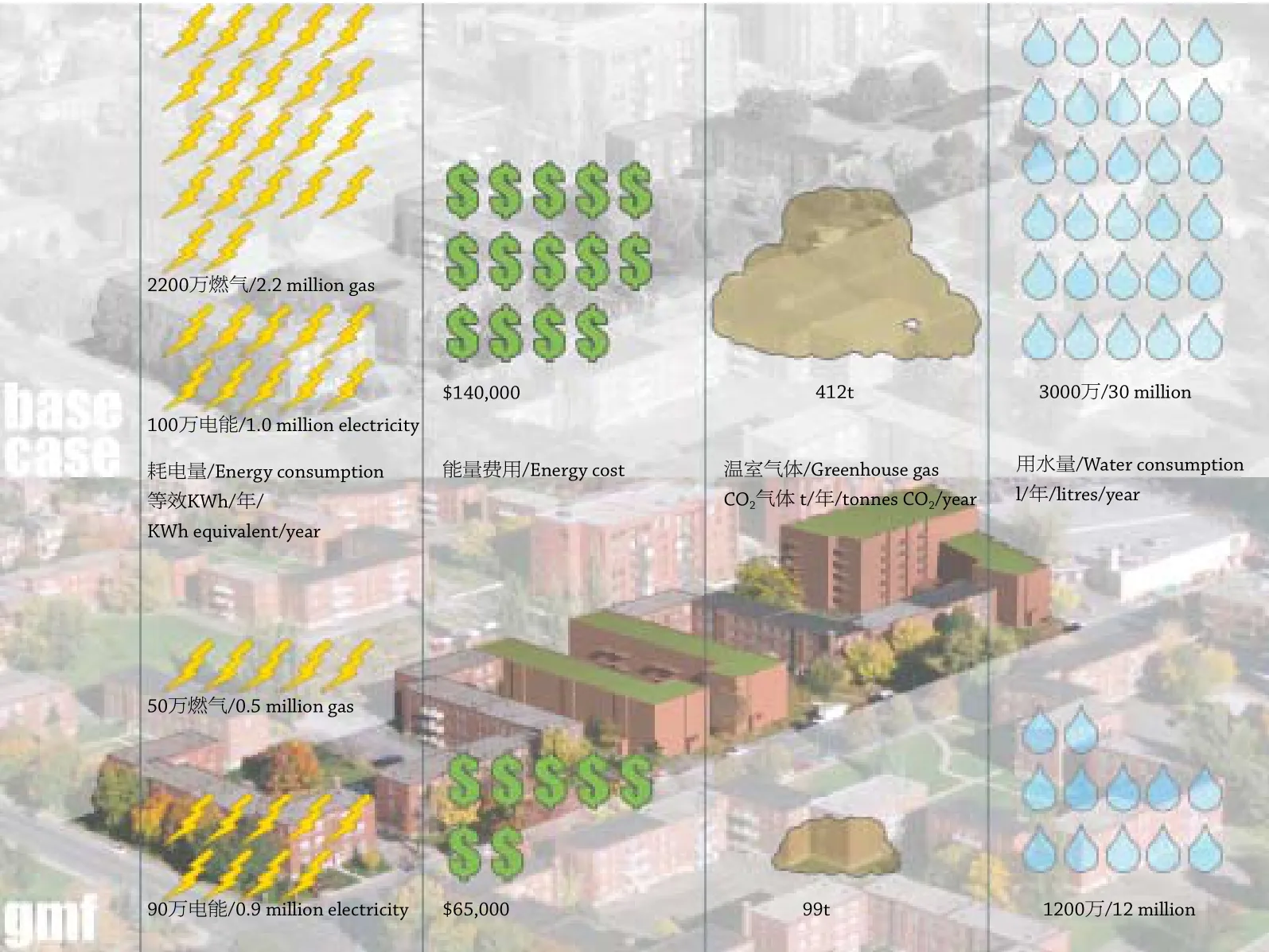
8 普遍情况与本尼农庄的对比/Base case vs. Benny farm
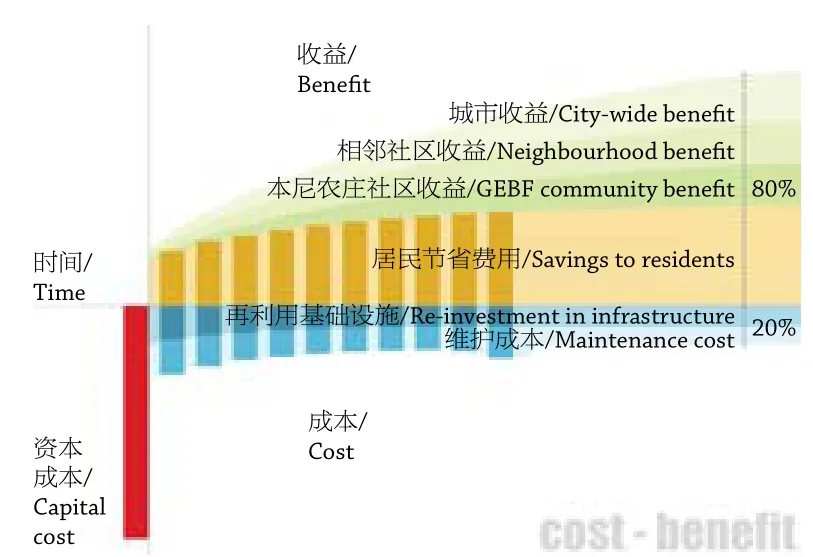
9 成本收益/Cost-benefit

10 总平面/Site plan
L'OEUF和所有参与本尼农庄的其他人的梦想是否会实现,生态逻辑概念是否会发挥作用,功能性社会结构能否在这里恢复——这一切只有再过若干年才能知道。丹尼尔·玻尔说:“你现在可以对我们的项目要多热情就多热情,虽然我们不能保证一切都会和我们的想象一样——但我相信一切都会变好!”精力充沛的合作者珍妮·梅奥哈哈大笑:“哦,丹尼尔总是这么乐观!”她知道,如果没有L'OEUF的努力,早在15年前,推土机就已经把本尼农庄的一切都结束了。(马里乌斯·罗通艾格 文)Farm an innovative project: "The innovative thing is that the project has created a new organization; its social orientation is innovative. Here young families and elderly people live together. Another innovation is that we are confronting industry with green infrastructure. We are not working with subtrade specialists because we cannot afford to. Te innovation is the combination of all these various steps!"
But this combination also raises many problems. "When you change one thing somewhere, everything else changes too!" Tat's why only 3 core buildings –from a total of about 20 buildings in the complex – are connected to the GEBF. Daniel Pearl: "Even with just 3 buildings the project was almost too complicated." The organizations involved have to count every penny. Daniel describes problems that arose when certain items overstepped the budget many times. These costs were not big, but they were enough to upset the sensitive financial structure of the project. For example, the engineer revised the mounting of the solar collectors to withstand greater wind loads –"Tat cost 20,000 dollars more! Additional costs mean we have to cut costs somewhere else."
Impossible without volunteer work
In the Benny Farm project literally every dollar is precious. The project is financed chiefly by the state, which then passes ownership of the buildings to the non-profit organizations. But now that the government money is spent, the project must carry itself. L'OEUF has invested uncounted man-hours for which it has never seen a cent. "Benny Farm has been a dilemma for us again and again over the past years. The project has taken so much of our energy that we have had to neglect some other things. If you don't have volunteers to carry such a project, then you don't have a project. To realize such a dream, you need people who are fully committed – even without any guarantee of ever being paid for it." Tat's why certain social changes com-plicate the realization of such projects. Daniel Pearl: "Earlier, many women were engaged in volunteer work. Today most women have jobs and less time for social projects." Women indeed played an outstanding role in this project, "but in this case it was often women from an older generation."
Half the normal market price
Jeanne Mayo is such a woman. Te lively retiree has been engaged in the project for years. She is chair of the board of directors of Coop Chez Soi, the nonprofit organization that manages the seniors home, and she also sits on the board of the GEBF. "I keep everything here in order," she says while swiftly signing checks and filling out the books. Te occupants in the seniors residence are between 65 and 94 years old and two thirds are women. Over half come from the neighborhood or have children living nearby. To qualify to live in the building, one's income must not exceed a certain limit. Te seniors pay 565 dollars a month for a modest one-room apartment, including electricity, heating and cable television –that's roughly half the normal market price.
Boom complicates financing
Even if these demonstration projects at Benny Farm do just barely make ends meet, the timing of the project is some-what unfortunate from the point of view of economic cycles. Well into the 1960s Montreal was an important goods distribution hub for Canada and the USA because ships could bring goods here via the St. Lawrence River. Then a canal was opened that allowed ships to bypass Montreal and access the Great Lakes. Montreal lost its privileged position, and at the same time the independence movement of the French-speaking Québécois disconcerted the large companies. Many companies moved their head offices to Toronto, Calgary or Vancouver. Thus up until the turn of the millennium, residential space in the inner city of Montreal was available at affordable prices. But Montreal's high quality of life was then rediscovered, demand for residential properties grew, and rental rates exploded. The city decided to invest in social housing again and to build 5,000 new apartment units over the past few years. The construction of social housing then boomed; contractors had too much work and prices consequently rose. Tis is why the renovation of the third housing project has not yet begun.
A long battle
Te apartment building for young families, ZOO (Zone of opportunity) has been occupied for quite some time. Of course the tenants particularly like the affordable conditions and the unusually beautiful environment – but many are also interested in the project itself. Daniel Pearl: "They see what effects our actions have and they recognize the connection between costs and energy consumption. Tey grew up during a time in which ecology was an issue. People recognize that things cannot continue as they have been going. Te planet was not necessarily better off 20 years ago than it was 10 years ago – but the thinking of the people has changed during that time." L'OEUF has been working on Benny Farm already for 15 years – and an end of the engagement is nowhere in sight. The office is over-seeing two projects as a consultant and has been directly responsible for the architecture of four projects (264 units in all). "We've had to fight a long battle," says Daniel Pearl. "Everything has been very involved, complicated, and labor intensive. We did something completely atypical: We started at the very bottom. Projects of this scale are typically designed from the top down, from the general concept to the details. Mark and I began the other way – with the details." The advantage of this method is that many painstakingly developed solutions can be easily adapted for use in other projects.
The demolition goes on
"We have been able to realize about two thirds of what we wanted to," says Daniel Pearl, "and that's a lot." It was not possible to save all the buildings. Another old residential building at Benny Farm, which could have been easily integrated into the project, will be torn down soon to make room for a medical clinic, although "there is plenty of space available in the neighborhood." Daniel smiles when he says that, even if it maybe hurts a little. But the architects of L'OEUF have learned to make compromises. And that's one reason their ideas are taken seriously. In Ottawa the government is now starting a huge project that is supposed to take advantage of the experience gained at Benny Farm.
It's not easy being green
In spite of the readiness to compromise, Daniel remains convinced: "As an architect, you have to have your own values; you have to live by your own philosophy!" Because L'OEUF will not let themselves be corrupted, and because they insist on going their own way, the success with Benny Farm sometimes puts them to the test. "Usually green projects are in the upper price segment – and we get offers today to work on expensive private homes. Working on affordable housing is important to us, but of course highprice residential buildings should also have a green infrastructure." Here Pearl ponders what he thinks is more important: pure ecology with no consideration of the socio-economic environment – or the combination of environmental and social concerns.
"We build one house a year at the most," he says. "And we choose our clients very deliberately. They have to be very green; they have to want to go our way. Nine out of ten potential clients who come to us don't even come into question for a commission." Being green is not easy – because in society, as at Benny Farm, everything is tied in with everything else. Daniel Pearl: "Montreal is a unique city – large and small at once. We oppose the trend of people moving to the suburban outskirts. This puts us in a dilemma sometimes – for instance, when the question arose whether the city metro should be extended into the suburbs. Of course I am against people driving into the city by car. But if we extend the metro to the suburbs now, this benefits above all the people who live even further away. Tat only feeds urban sprawl."
Optimism as a foundation
Whether the dream of L'OEUF and everyone else involved in Benny Farm will ever be fulfilled, whether the eco-logical concepts will work, whether a functioning social structure can be regained here – all this will be known only after some years pass. Daniel Pearl: "You can be as enthusiastic as you want about our project right now, but we have no guarantee that it will all turn out as we envision – but I am secure it will all turn out well!" Jeanne Mayo, the energetic collaborator, laughs: "Oh, Daniel is always so optimistic!" And she knows that if L'OEUF weren't, the bulldozers would have finished their work at Benny Farm 15 years ago.(Text: Marius Leutenegger)

